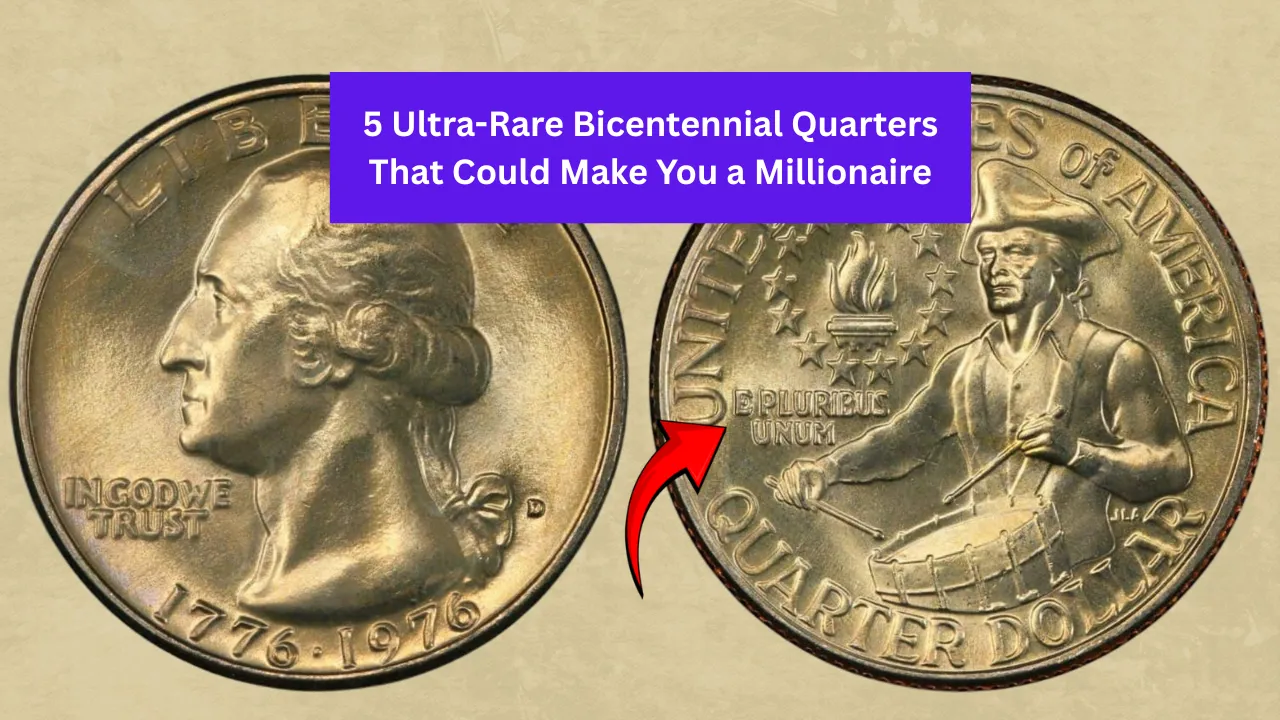Think quarters are just pocket change? Think again. Some quarters, especially from the U.S. Bicentennial celebration in 1976, are worth far more than 25 cents. In fact, a handful of ultra-rare Bicentennial quarters have fetched up to six-figure and even seven-figure sums at auctions.
If you’ve got an old coin jar or loose change lying around, you might want to give it a second look. Here are five ultra-rare Bicentennial quarters that could turn you into a millionaire.
What Makes Bicentennial Quarters Special?
To celebrate America’s 200th birthday in 1976, the U.S. Mint released special commemorative quarters featuring a unique reverse design. Instead of the traditional eagle, these coins show a Colonial drummer and a torch surrounded by 13 stars, representing the original colonies.
Although millions were minted in 1975 and 1976 (all bearing the 1776–1976 date), a small number of errors, rare metal compositions, and special strikes have made a few of these quarters incredibly valuable.
1. 1976-S Silver Proof Bicentennial Quarter (No “S” Mint Mark Error)
Estimated Value: $600,000 – $1,000,000+
One of the rarest and most mysterious Bicentennial quarters ever discovered is a 1976-S Silver Proof quarter that was mistakenly struck without the “S” mint mark.
- Only one known example exists.
- It was struck in 40% silver at the San Francisco Mint but lacks the identifying “S.”
- Because it shouldn’t exist, it’s a numismatic unicorn.
This coin is so rare that collectors speculate it was a mint error that escaped quality control. If another one surfaces, it could easily break the $1 million mark at auction.
2. 1976 Bicentennial Double Die Obverse Quarter
Estimated Value: $5,000 – $25,000+
Double die errors occur when the coin’s design is accidentally stamped twice at slightly different angles. In the Bicentennial quarter series, this error happened on the obverse side (the side with Washington’s portrait).
- Look for doubling in the word “LIBERTY” or “IN GOD WE TRUST.”
- Some examples show strong, clear doubling visible to the naked eye.
Though not as rare as the no-mint-mark silver proof, a strong double die Bicentennial quarter in high grade can fetch tens of thousands of dollars, especially among error coin collectors.
3. 1976-S Bicentennial Silver Uncirculated Quarter
Estimated Value: $1,000 – $10,000+
The U.S. Mint released a special collector’s edition of the Bicentennial quarter in 40% silver, available only in mint sets. While many were preserved, a few high-grade uncirculated coins are worth thousands today.
- These quarters have an “S” mint mark.
- Look for uncirculated coins in perfect or near-perfect condition (MS67 or higher).
- Most valuable when still sealed in original mint packaging.
A pristine silver Bicentennial quarter could easily top $10,000 at auction—especially if graded by PCGS or NGC.
4. 1976-D Bicentennial Quarter Struck on a 90% Silver Planchet
Estimated Value: $50,000 – $250,000
In a rare minting mistake, a Denver Mint Bicentennial quarter was struck on a 90% silver planchet intended for older coins like pre-1965 quarters.
- These are error coins that should not exist.
- They are heavier and have a distinct silver “ring” when dropped.
A few authenticated examples have sold at high-end auctions for six figures. If you find a D-mint Bicentennial quarter that weighs more or looks brighter than normal, have it checked by a coin grading service—it could be a treasure.
5. 1976-S Bicentennial Silver Proof Deep Cameo (PR70DCAM)
Estimated Value: $7,000 – $25,000+
Proof coins are specially struck for collectors using polished dies and high-pressure strikes, resulting in a mirror-like finish. A “Deep Cameo” proof is the highest level of contrast and detail.
- Only a handful have been graded a perfect PR70DCAM.
- These are the crème de la crème of Bicentennial quarters.
If you happen to have one tucked away in a proof set, it could be worth thousands or more, especially if certified by PCGS or NGC.
How to Tell If You Have a Valuable Bicentennial Quarter
Here’s what to look for:
Check the mint mark: Look for “S” (San Francisco), “D” (Denver), or no mark (Philadelphia).
Look at the edges: A solid silver edge indicates a silver coin; a copper line means it’s clad.
Use a scale: Silver quarters weigh 5.75g, while clad versions weigh 5.67g.
Examine with magnification: Doubling or off-strike features can mean big money.
Check for luster and condition: Higher-grade coins are significantly more valuable.
Final Thoughts
While most Bicentennial quarters are only worth their face value, a select few can be worth tens or even hundreds of thousands of dollars—and in rare cases, over $1 million. Whether you’re a seasoned collector or a casual coin saver, it pays to check your change.
Who knows? That old quarter rattling around in your car’s cupholder might just change your life.
FAQs
Q1: How can I tell if my Bicentennial quarter is silver?
Check the edge—if it’s solid silver (no copper stripe) and weighs 5.75g, it could be a 40% silver version.
Q2: Are all 1976 quarters valuable?
No. Most are common, but rare mint errors, silver compositions, and perfect condition coins can be worth thousands.
Q3: Where can I sell a valuable Bicentennial quarter?
Auction houses like Heritage Auctions or grading services like PCGS and NGC can help you authenticate and sell your coin.
Q4: Should I clean my coin before selling it?
Never clean a coin. Cleaning can damage it and reduce its value dramatically.
